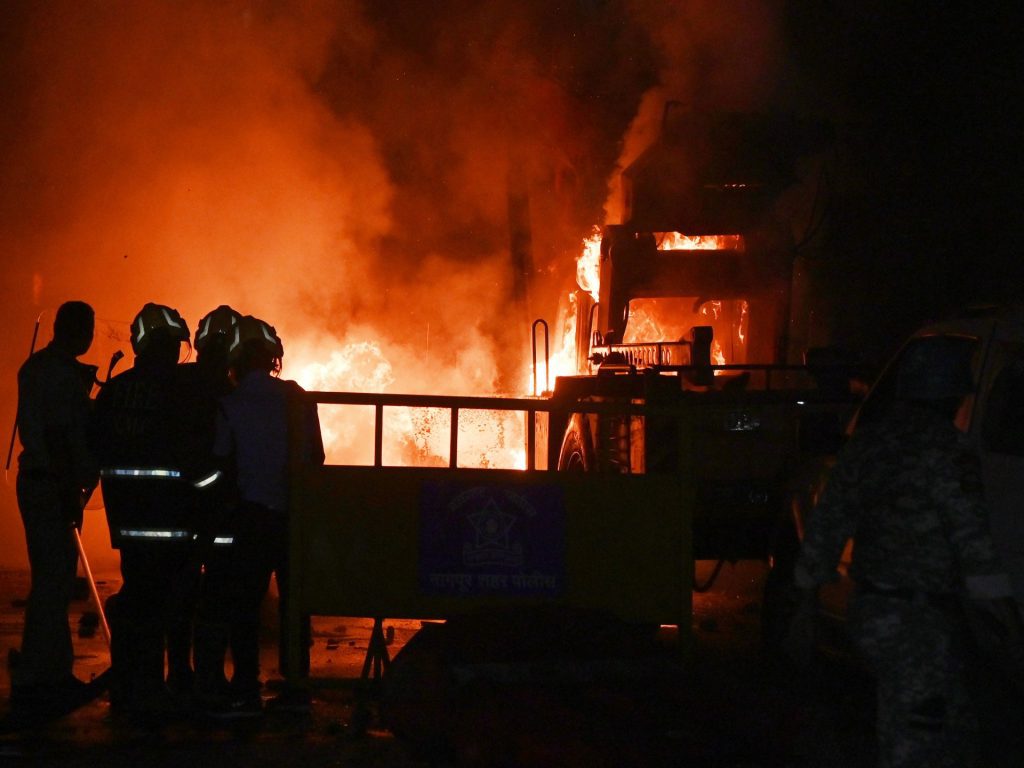New Delhi, India – Datta Shirke has remained indoors for the past two days, anxious about his family’s safety. In his neighborhood, vehicles have been set ablaze amidst Hindu-Muslim confrontations.
Aslam, who prefers to be identified by his first name, lives just a mile away and shares similar fears. He is reluctant to return home, where he resides with his wife and mother, worrying that he might be wrongfully arrested by police, whom he accuses of detaining innocent Muslims. “I have done nothing. But when police arrive, they seem to be looking for our blood,” he stated.
Both reside in Nagpur, a city with three million inhabitants in Maharashtra’s western region, where violence erupted on Monday regarding the future of the tomb of Aurangzeb, a 17th-century Mughal emperor.
Authorities have imposed a curfew, and police have arrested over 50 individuals, primarily Muslims, during raids leading up to Prime Minister Narendra Modi’s planned visit to Nagpur on March 30. Notably, the city is also home to the Rashtriya Swayamsevak Sangh (RSS), the ideological foundation of Modi’s Bharatiya Janata Party (BJP) and its Hindu nationalist partners.
Why Did Nagpur Erupt in Violence?
The unrest began after a BJP parliamentarian from Maharashtra suggested excavating the Mughal emperor’s grave. On Monday, approximately 100 volunteers from the far-right group Vishwa Hindu Parishad (VHP) protested in Nagpur, calling for the tomb’s demolition, claiming that Aurangzeb discriminated against Hindus and attacked their temples during his reign from 1658 to 1707.
“That grave is a blight on our homeland,” declared Amit Bajpai, a VHP spokesperson and one of the protest’s organizers. They burned an effigy of Aurangzeb wrapped in green cloth while the police looked on. Asif Qureshi, a local lawyer, mentioned that the demonstration sparked outrage among Muslim shopkeepers, particularly as it fell during Ramadan. Rumors spread that the green cloth had Quranic verses, inciting Muslims to organize a counterprotest demanding police action against the VHP members.
Who Was Aurangzeb?
Aurangzeb was one of the most significant rulers in the Indian subcontinent, yet his grave is not in Nagpur but over 450 km away in what was once named Aurangabad and is now called Chhatrapati Sambhajinagar. The name change was influenced by Hindu nationalist groups who consider Aurangzeb one of India’s most notorious villains. Historians argue, however, that his legacy is more nuanced than commonly believed.
Why is Aurangzeb So Divisive in India?
Many historians assert that rulers of the past, including Aurangzeb, were not especially remarkable compared to other kings of their era. However, British colonial narratives cast him negatively, a sentiment echoed by modern Hindu nationalist groups. This anti-Aurangzeb sentiment has resulted in increasing acts of aggression, including arrests related to public displays of his imagery and significant revisions in school history curricula regarding the Mughal Empire.
As communal tensions persist in Nagpur, residents, particularly Muslims, express fears about potential future violence. Shirke voiced, “There is no trust or faith in each other,” while Qureshi emphasized the anxious anticipation of raids among Muslim residents. Historian Audrey Truschke remarked that the current fixation on historical disputes reflects a deeper animosity towards Muslims. “But litigating over 17th-century events is an absurd notion,” she concluded.



